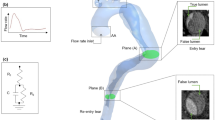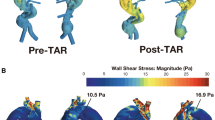Abstract
Background: Combination of computational fluid dynamic (CFD) technique and medical data (AngioCT and USG-Doppler data) allowed preparation of a non-invasive method for blood hemodynamic analysis in type B aortic dissection (TBAD). Materials and methods: Three-dimensional digital models of the aorta were reconstructed using pre- and post-operative data from a 39-year-old patient treated for acute TBAD with thoracic endovascular aortic repair (TEVAR). Moreover, the left renal artery and the right common iliac artery were treated with additional stents. CFD technique was used to quantify the displacement forces acting on the aortic wall in the areas of endograft and validated with USG-Doppler data. The aortic segment was extended from the origin of the aortic arch to the aortic bifurcation. Results: Our results indicated that prostheses implantation improved overall aortic blood flow. We observed that blood flow rate was around two-fold higher in branching arteries of the aorta after surgical procedure. The wall shear stress (WSS) values were lower in all analysed areas. Hence, the overall risk of dissection propagation and rupture was decreased. Conclusion: CFD technique may provide qualitative assessment of hemodynamic forces in the aorta before and after prostheses implantation and may have potential in aiding the therapeutic decision-making process after operation.
Access this chapter
Tax calculation will be finalised at checkout
Purchases are for personal use only
Similar content being viewed by others
References
Amblard, A., Berre, H.W.L., Bou-Said, B., Brunet, M.: Analysis of type I endoleaks in a stented abdominal aortic aneurysm. Med. Eng. Phys. 31, 27–33 (2009). https://doi.org/10.1016/j.medengphy.2008.03.005
Auer, M., Gasser, T.C.: Reconstruction and finite element mesh generation of abdominal aortic aneurysms from computerized tomography angiography data with minimal user interactions. IEEE Trans. Med. Imaging 29, 1022–1028 (2010). https://doi.org/10.1109/TMI.2009.2039579
Blanco, P.J., Pivello, M.R., Urquiza, S.A., Feijoo, R.A.: On the potentialities of 3D-1D coupled models in hemodynamics simulations. J. Biomech. 42, 919–930 (2009). https://doi.org/10.1016/j.jbiomech.2009.01.034
Cheng, Z., et al.: Analysis of flow patterns in a patient-specific aortic dissection model. J. Biomech. Eng. 132, 051007 (2010). https://doi.org/10.1115/1.4000964
Dake, M.D., et al.: Endovascular stent-graft placement for the treatment of acute aortic dissection. New Engl. J. Med. 340, 1546–1552 (1999). https://doi.org/10.1056/NEJM199905203402004
Doyle, B.J., Callanan, A., Burke, P.E., Grace, P.A., Walsh, M.T., Vorp, D.A., McGloughlin, T.M.: Vessel asymmetry as an additional diagnostic tool in the assessment of abdominal aortic aneurysms. J. Vasc. Surg. 49, 443–454 (2009). https://doi.org/10.1016/j.jvs.2008.08.064
Duvernois, V., Marsden, A.L., Shadden, S.C.: Lagrangian analysis of hemodynamics data from FSI simulation. Int. J. Numer. Methods Biomed. Eng. 29, 445–461 (2013). https://doi.org/10.1002/cnm.2523
Georgakarakos, E., Ioannou, C.V., Kamarianakis, Y., Papaharilaou, Y., Kostas, T., Manousaki, E., Katsamouris, A.N.: The role of geometric parameters in the prediction of abdominal aortic aneurysm wall stress. Eur. J. Vasc. Endovasc. Surg. Off. J. Eur. Soc. Vasc. Surg. 39, 42–48 (2010). https://doi.org/10.1016/j.ejvs.2009.09.026
Hagan, P.G., et al.: The International Registry of Acute Aortic Dissection (IRAD): new insights into an old disease. JAMA J. Am. Med. Assoc. 283, 897–903 (2000)
Herman, I.M., Brant, A.M., Warty, V.S., Bonaccorso, J., Klein, E.C., Kormos, R.L., Borovetz, H.S.: Hemodynamics and the vascular endothelial cytoskeleton. J. Cell Biol. 105, 291–302 (1987)
Hoshina, K., Sho, E., Sho, M., Nakahashi, T.K., Dalman, R.L.: Wall shear stress and strain modulate experimental aneurysm cellularity. J. Vasc. Surg. 37, 1067–1074 (2003). https://doi.org/10.1067/mva.2003.169
Hoskins, P.R.: Simulation and validation of arterial ultrasound imaging and blood flow. Ultrasound Med. Biol. 34, 693–717 (2008). https://doi.org/10.1016/j.ultrasmedbio.2007.10.017
Karmonik, C., et al.: Longitudinal computational fluid dynamics study of aneurysmal dilatation in a chronic DeBakey type III aortic dissection. J. Vasc. Surg. 56, 260–263, e261 (2012). https://doi.org/10.1016/j.jvs.2012.02.064
Kizilova, N.: Computational approach to optimal transport network construction in biomechanics. Lect. Notes Comput. Sci. 3044, 476–485 (2004)
Lam, S.K., Fung, G.S., Cheng, S.W., Chow, K.W.: A computational study on the biomechanical factors related to stent-graft models in the thoracic aorta. Med. Biol. Eng. Comput. 46, 1129–1138 (2008). https://doi.org/10.1007/s11517-008-0361-8
Nienaber, C.A., et al.: Nonsurgical reconstruction of thoracic aortic dissection by stent-graft placement. New Engl. J. Med. 340, 1539–1545 (1999). https://doi.org/10.1056/NEJM199905203402003
Papathanasopoulou, P., et al.: MRI measurement of time-resolved wall shear stress vectors in a carotid bifurcation model, and comparison with CFD predictions. J. Magn. Reson. Imaging JMRI 17, 153–162 (2003). https://doi.org/10.1002/jmri.10243
Piechota, A., Polanczyk, A., Goraca, A.: Role of endothelin-1 receptor blockers on hemodynamic parameters and oxidative stress. Pharmacol. Rep. 62, 7 (2010)
Piechota, A., Polanczyk, A., Goraca, A.: Protective effects of endothelin-A receptor antagonist BQ123 against LPS-induced oxidative stress in lungs. Pharmacol. Rep. 63, 7 (2011)
Polanczyk, A., Klinger, M., Nanobachvili, J., Huk, I., Neumayer, C.: Artificial circulatory model for analysis of human and artificial vessels. Appl. Sci. 8, 12 (2018). https://doi.org/10.3390/app8071017
Polanczyk, A., Piechota-Polanczyk, A., Domenig, C., Nanobachvili, J., Huk, I., Neumayer, C.: Computational fluid dynamic accuracy in mimicking changes in blood hemodynamics in patients with acute type IIIb aortic dissection treated with TEVAR. Appl. Sci. 8, 14 (2018). https://doi.org/10.3390/app8081309
Polanczyk, A., Piechota-Polanczyk, A., Stefanczyk, L.: A new approach for the pre-clinical optimization of a spatial configuration of bifurcated endovascular prosthesis placed in abdominal aortic aneurysms. PloS One 12, e0182717 (2017). https://doi.org/10.1371/journal.pone.0182717
Polanczyk, A., Podgorski, M., Polanczyk, M., Veshkina, N., Zbicinski, I., Stefanczyk, L., Neumayer, C.: A novel methodology for the description of biomechanical properties of aortic wall based on three-dimensional fluid structure interaction model. Interact. Cardiovasc. Thorac. Surg. 10 (2018). https://doi.org/10.1093/icvts/ivy252
Polanczyk, A., Podgorski, M., Wozniak, T., Stefanczyk, L., Strzelecki, M.: Computational fluid dynamics as an engineering tool for the reconstruction of hemodynamics after carotid artery stenosis operation: a case study. Medicina 54, 15 (2018). https://doi.org/10.3390/medicina54030042
Polanczyk, A., Podyma, M., Stefanczyk, L., Szubert, W., Zbicinski, I.: A 3D model of thrombus formation in a stent-graft after implantation in the abdominal aorta. J. Biomech. 48, 425–431 (2015). https://doi.org/10.1016/j.jbiomech.2014.12.033
Polanczyk, A., Podyma, M., Stefanczyk, L., Zbicinski, I.: Effects of stent-graft geometry and blood hematocrit on hemodynamic in Abdominal Aortic Aneurysm. Chem. Process Eng. 53–62 (2012). https://doi.org/10.2478/v10176-012-0005-2
Polanczyk, A., Podyma, M., Trebinski, L., Chrzastek, J., Zbicinski, I., Stefanczyk, L.: A novel attempt to standardize results of CFD simulations basing on spatial configuration of aortic stent-grafts. PloS One 11, e0153332 (2016). https://doi.org/10.1371/journal.pone.0153332
Polanczyk, A., Strzelecki, M., Wozniak, T., Szubert, W., Stefanczyk, L.: 3D blood vessels reconstruction based on segmented CT data for further simulations of hemodynamic in human artery branches. Found. Comput. Decis. Sci. 42, 13 (2017). https://doi.org/10.1515/fcds-2017-0018
Polanczyk, A., Wozniak, T., Strzelecki, M., Szubert, W., Stefanczyk, L.: Evaluating an algorithm for 3D reconstruction of blood vessels for further simulations of hemodynamic in human artery branches. In: Signal Processing—Algorithms, Architectures, Arrangements, and Applications Conference Proceedings, SPA 5 (2016). https://doi.org/10.1109/spa.2016.7763595
Shahcheraghi, N., Dwyer, H.A., Cheer, A.Y., Barakat, A.I., Rutaganira, T.: Unsteady and three-dimensional simulation of blood flow in the human aortic arch. J. Biomech. Eng. 124, 378–387 (2002)
Suzuki, T., et al.: Clinical profiles and outcomes of acute type B aortic dissection in the current era: lessons from the International Registry of Aortic Dissection (IRAD). Circulation 108(Suppl 1), II312–317 (2003) https://doi.org/10.1161/01.cir.0000087386.07204.09
Tse, K.M., Chiu, P., Lee, H.P., Ho, P.: Investigation of hemodynamics in the development of dissecting aneurysm within patient-specific dissecting aneurismal aortas using computational fluid dynamics (CFD) simulations. J. Biomech. 44, 827–836 (2011). https://doi.org/10.1016/j.jbiomech.2010.12.014
Xenos, M., et al.: Patient-based abdominal aortic aneurysm rupture risk prediction with fluid structure interaction modeling. Ann. Biomed. Eng. 38, 3323–3337 (2010). https://doi.org/10.1007/s10439-010-0094-3
**ang, J., Tremmel, M., Kolega, J., Levy, E.I., Natarajan, S.K., Meng, H.: Newtonian viscosity model could overestimate wall shear stress in intracranial aneurysm domes and underestimate rupture risk. J. Neurointerventional Surg. 4, 351–357 (2012). https://doi.org/10.1136/neurintsurg-2011-010089
Acknowledgements
The study was supported by grant number 181110 from the Medical University of Vienna, Department of Surgery.
Author information
Authors and Affiliations
Corresponding author
Editor information
Editors and Affiliations
Rights and permissions
Copyright information
© 2019 Springer Nature Switzerland AG
About this paper
Cite this paper
Polanczyk, A., Piechota-Polanczyk, A., Neumayer, C., Huk, I. (2019). CFD Reconstruction of Blood Hemodynamic Based on a Self-made Algorithm in Patients with Acute Type IIIb Aortic Dissection Treated with TEVAR Procedure. In: Gutschmidt, S., Hewett, J., Sellier, M. (eds) IUTAM Symposium on Recent Advances in Moving Boundary Problems in Mechanics. IUTAM Bookseries, vol 34. Springer, Cham. https://doi.org/10.1007/978-3-030-13720-5_7
Download citation
DOI: https://doi.org/10.1007/978-3-030-13720-5_7
Published:
Publisher Name: Springer, Cham
Print ISBN: 978-3-030-13719-9
Online ISBN: 978-3-030-13720-5
eBook Packages: EngineeringEngineering (R0)




